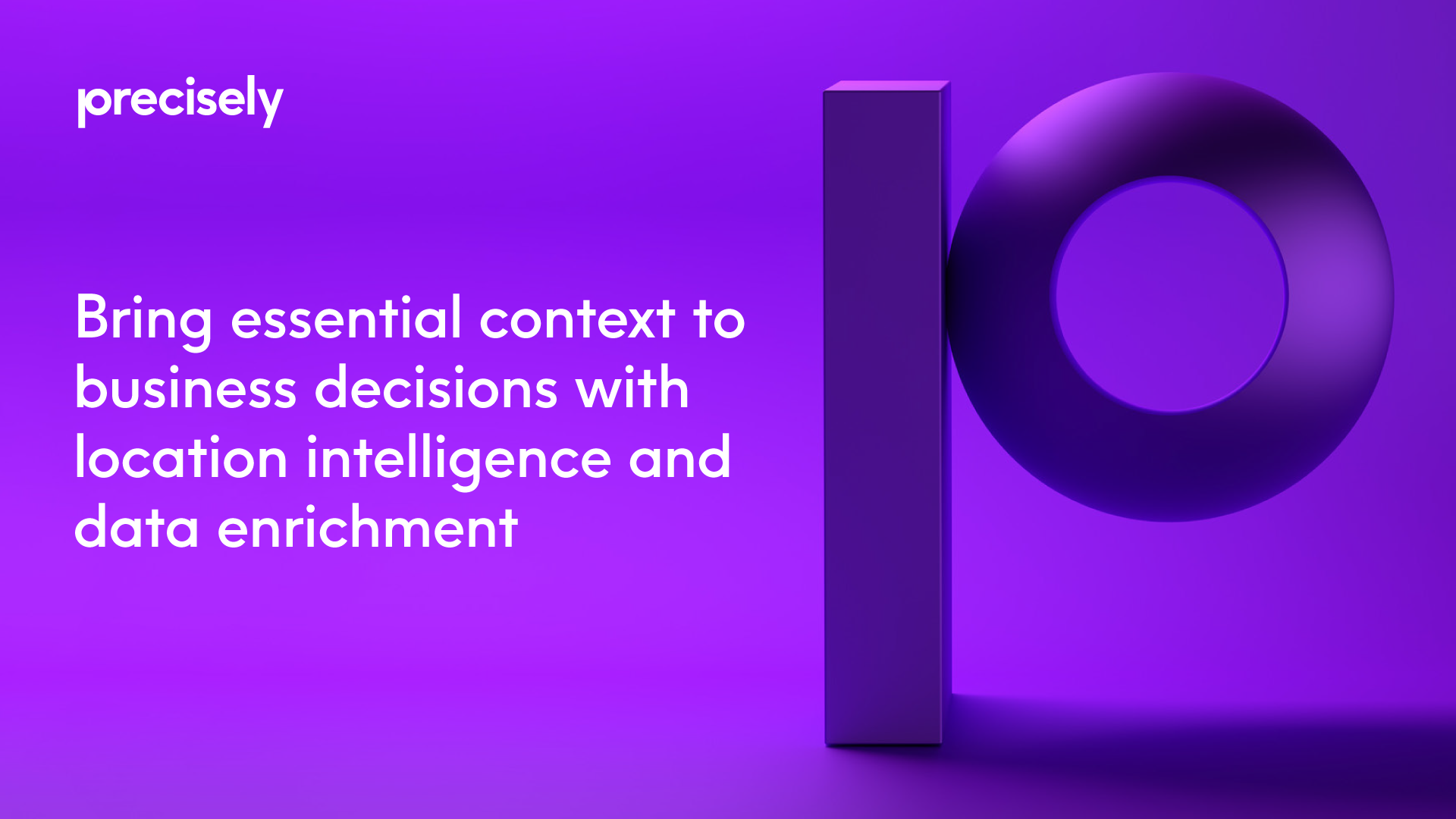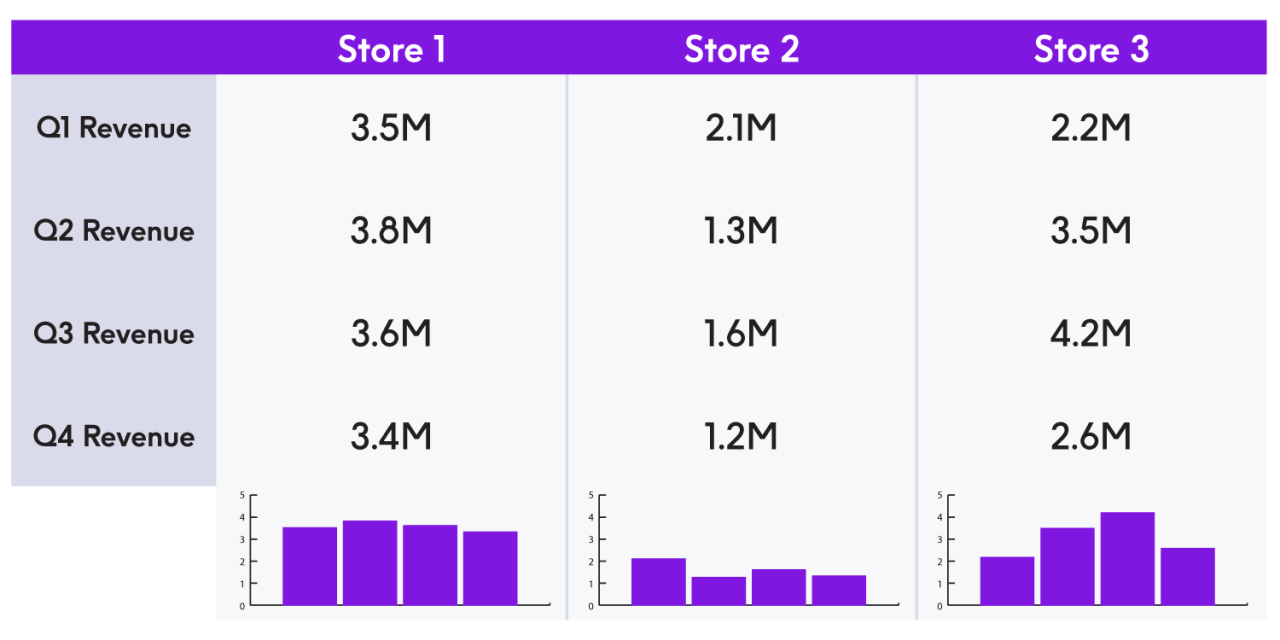eBook
Bring Essential Context to Business Decisions with Location Intelligence and Data Enrichment
Data integrity empowers success in business initiatives
While every company’s business initiatives are unique, there is one common denominator required for success that crosses all industries: data. Whether your organization’s focus is improving the customer experience, automating operations, mitigating risk, or accelerating growth and profitability, you’ll find these initiatives are all data driven.
Data integrity is essential to the success of any initiative.
The 2023 Data Integrity Trends and Insights Report from Drexel University’s LeBow Center for Business Analytics reveals that respondents value data-driven decision-making and rely on location data to deliver trusted insights.
Still, they operate in an environment where resources are constrained, trust in data is low, and data quality challenges impact all aspects of data integrity.

77%
say data-driven decision-making is the top goal of their data programs
only 46%
rate their data quality as “high” or “very high”
53%
rank data quality as their top priority for improving data integrity
76%
report reliance on accurate location data for decision-making.
Data with integrity is trusted to be accurate, consistent, and contextual. However, building data integrity is challenging for most organizations. Data is siloed, stale, inconsistent, incomplete, full of duplicates, and incapable of delivering trusted insights or creating business value.
Continuously improving data integrity requires integrating data silos, delivering quality data that is trusted and fit for purpose, leveraging data observability to proactively identify data issues before they impact the business, and understanding data policies and processes with insight into data’s meaning, lineage, and impact.
This eBook will focus on two key elements of data integrity: location intelligence and data enrichment. These elements build the context you need around your data to unlock valuable, hidden insights and reveal critical relationships so you can make better business decisions every day.

The business value of context
Add context to your business data and proceed from “who” and “what” to “where” and “why.” Context expands your understanding of the places, surroundings, people, and behaviors that impact business activity — giving you a substantially better-informed view of your business.
Let’s start with a simple and pervasive example: bar charts that show quarterly revenue by location. These locations can be stores, restaurants, offices, territories, branches, and the like. If you only look at revenue by location, you are restricted to a one-dimensional view of business performance.

To get a bigger picture that starts to answer “why,” add context to your understanding of each location or service area. What is the neighborhood like – retirees, young families, established professionals? How many people live in the area, and what’s their income? Are they commuters, or do they work locally? What kinds of businesses are within walking distance of yours? How close are your competitors? Will weather patterns in this area impact business volumes?
Context provides the insight you need to recognize market trends and shifting customer preferences, so you can anticipate future demand and make informed, confident decisions about your business. Ultimately, context is the crucial component that builds data integrity and fuels optimized business processes, product innovation, and more personalized customer experiences.

Here’s how context delivers business value by advancing data analytics, identifying patterns, and enabling better decisions for these industries and business functions:
Property and casualty insurance: Improve underwriting by better understanding property risks related to co-tenancy, adjacency, and proximity to high-risk zones for fire, flood, and other natural hazards. Speed claims processing and sharpen fraud analytics.
Financial services: Increase mortgage lending visibility into factors such as property owner and environmental risk. Reduce commercial loan risk by better understanding the properties used as collateral. Optimize branch networks. Identify patterns that indicate fraud.
Government: Improve resource allocation and deliver better quality services with a holistic view of people, properties, assets, infrastructure, and districts. Effectively locate underserved areas. Plan and execute broadband and infrastructure initiatives. Strengthen funding requests for new programs. Analyze crime patterns. Allocate emergency response resources to meet population shifts.
PropTech: Achieve a single, comprehensive view of a property for better-informed asset valuation. Understand clients and demographics. Enrich marketing materials with neighborhood profiles.
Retail and restaurants: Analyze customers, catchment areas, and competitors. Make richly informed site selection decisions. Understand why different locations under- or over-perform. Predict demand. Model delivery patterns and optimize delivery routing.
Telecommunications and broadband: Optimize network design, including 5G antenna placements, based on new customer potential. Uncover serviceable locations within multi-dwelling and multi-tenant units. Identify gaps in coverage.
Healthcare: Segment markets for medical services. Identify underserved areas by medical specialty and facility type. Understand population movement and demographic trends. Monitor infectious disease spread.
Advertising and marketing: Create targeted, timely, and relevant marketing offers to drive customer acquisition and growth programs. Send real-time ads and coupons when a user is in a particular area. Create smarter segmentation based on data. Personalize offers and communications.
Supply chain: Prioritize resource allocation based on which retail outlets have the highest traffic. Optimize warehouse locations and route planning.
Providing context and building data integrity with location intelligence and data enrichment
Location intelligence and data enrichment are key components of data integrity that companies in many industries overlook or fail to fully capitalize on. Without these essential elements, you’re left with messy, inefficient data that can’t provide the insight you need to recognize market trends and shifting customer preferences — making it difficult to make plans and anticipate future demand.
However, using addresses in your business data, and combining them with third-party and geospatial data produces powerful, contextualized information that fuels more confident decisions. The Precisely approach to location intelligence and our regularly updated, international enrichment datasets make it fast and easy to bring context to your data and build data integrity. Here’s how we do it.


Ensure the integrity of your address data
Working with addresses that belong to your customers, prospects, properties, and employees at scale is an essential data operations function for most businesses. These addresses exist in your CRM, billing, ERP, business intelligence, data warehouse, and workforce management applications and databases.
The assumption is that using address data to gain business insight is something organizations easily do — but that’s not necessarily the case.
It can be challenging to parse, standardize, match, verify/validate, and connect addresses across your organization. When addresses are wrong, it costs money. Opportunities are missed, brand reputation is jeopardized, and customer loyalty is at risk. When addresses are correct, you can comply with customer notification requirements, reduce returns of mail and e-commerce shipments, increase efficiency in deliveries and service calls, and enhance marketing campaigns.
While there is a wide range of products on the market that can verify addresses, they are not all created equal. That’s why having the most complete and accurate international address reference dataset along with best-in-class parsing and matching algorithms set Precisely geo addressing capabilities apart.
Streamline data enrichment with geo addressing
Precisely geo addressing solutions integrate both addressing and geocoding capabilities to provide the highest levels of accuracy in both addressing and location data available. There’s no question about the importance of address-matching software – it’s a critical component when working with business address data. But it’s equally important to remember that these tools always come with a margin of possible error.
That’s why a unique identifier is key. Just like a fingerprint removes ambiguity about a person’s identity, a unique identifier resolves questions about an address and its location. It provides an accurate and consistent view of an address and facilitates linking that address across systems or joining new datasets.
The PreciselyID fits that bill. You’ll find it attached to our address datasets and can easily add it to business addresses using our geo addressing solutions. What exactly does that mean in action? It means that alias address records aren’t counted as duplicates when address strings change; that when a street name or postal code changes, the PreciselyID remains consistent – leading to more accurate analytics.
The PreciselyID is also used in data enrichment to quickly obtain contextual information about an address. Appended to thousands of data points, it links an address to points of interest, property, demographic, and boundary datasets. Performing a quick and straightforward lookup of a PreciselyID returns a variety of rich information related to that specific geocoded record.
Precisely’s tools help you manage and organize business data to bring greater location context to your analysis. The unique and persistent nature of the PreciselyID facilitates quick and easy data enrichment. Joining different datasets together empowers you to analyze an address from multiple perspectives and eliminate time-consuming spatial processing.
“80% of data executives say that consistently enriching data at scale is either 'very challenging' or “quite challenging.”
Corinium ResearchAdd context with enrichment data
To build data with integrity, you need to enrich your data, making it more complete, and setting your business apart from the competition. With the powerful insights provided by context, you can improve targeting, reduce costs, reduce risk, and increase revenue.
Precisely’s Enrich product portfolio of more than 9000 attributes in over 400 datasets includes static data like geodemographics, census information, world points of interest, world boundaries, postal code boundaries, building attributes, and boundaries for flood, fire, and other risks. Dynamic datasets include demographic movement or weather changes over time.

Ensure that enrichment data is “fit for your purpose”
The marketplace for contextual data is continually growing. It includes open (free) datasets from government agencies such as Data.gov in the United States as well as third-party data providers like Precisely. Contextual data that meets your business needs can propel your business, but poor quality can lead to lost opportunities.
High internal costs are also associated with sourcing, prepping, integrating, and maintaining datasets in your business. Here are five essential criteria you can use for evaluating data products:
- Coverage. Examine the geographic areas for which the data is available. Are the areas granular enough to answer the questions your business is asking? Is the data consistent and comprehensive for small towns and rural areas as well as major cities?
- Completeness. Each data record can contain many fields. Consider the fill rate for each field within the dataset. The more fields that are left blank or contain null values, the less valuable the data.
- Accuracy. Is the data accurate, and how will you know? Consider working with a provider that allows statistical sampling of their datasets, enabling you to cross-check sampled data with authoritative information. How well do the datasets reflect the real world?
- Currency. Determine how frequently your provider updates data. Ask how long it takes for datasets to reflect real-world changes. Use an example based on your use case. For example, you may want to ask questions such as “If a farmhouse on a 50-acre parcel is demolished, and a developer builds 200 townhouses on that site, how long does it take for updated information on this parcel to be reflected in your dataset?”
- Consistency. Ask a potential data provider questions such as “What is your on-time delivery rate?” “How standardized is the data format, and when was the last time it was changed?” Also determine how easily the dataset works with your existing business data and software. You want to make sure your data input, storage, extraction, and analytics processes are as consistent as possible.
Precisely’s Enrich product portfolio and software capabilities are designed to work together saving you time and resources. As one customer executive recently said: “Every minute we spend prepping the data is one less minute we spend using the data to inform our decisions.” The less time you spend sourcing, prepping, and maintaining data, the quicker you can get to insight.
“Every minute we spend prepping the data is one less minute we spend using the data to inform our decisions.”
Unlock hidden insights with spatial analytics
No discussion of context would be complete without understanding the role location plays in our everyday lives. Through our mobile phones, fitness trackers, store and doctor locators, and other apps, we use geospatial data today without even thinking about it.
While using location in business decision-making may be expected, working with geospatial data is tricky. It requires a unique set of spatial analytical capabilities that may be hard to come by, advanced systems, and expert users. Even with those tools and capabilities, location-based insights stay within specialized departments. In a recent Forrester study, 52% of business leaders surveyed said they don’t have the right technical skills or knowledge required to use location intelligence more effectively.
It can be hard to access, interpret, and analyze spatial data, but that doesn’t mean you should miss out on key insights that could propel your business forward.
Unlike other companies, Precisely can make extremely large volumes of location-based information available in tabular format, boosting business analytics with deeper context and streamlining decision-making across many organizational levels. Our solutions can be integrated into any workflow or analytics tools, enabling business users to query and aggregate data based on distance, drivetime, density, and more. You can present the results through business intelligence dashboards to drive more efficient and enlightened decisions.
Precisely can also help you democratize spatial data by providing non-technical users with access to spatial insights integrating them into existing business applications, providing a tailored experience for your business users, or through workflow integration. By democratizing access to spatial data, you can enable business users across your organization to increase customer satisfaction, better meet business-critical metrics, and drive new business. For example, call center staff can direct consumers to your nearest location, marketing can discover a universe of new customers that look just like your best customer, and underwriting can understand a property’s relationship to potential risk factors such as lakes, rivers, coastlines, or wildfire zones.
“52% of business leaders surveyed say they don’t have the right technical skills or knowledge required to use location intelligence effectively.”
Forrester Research
Why work with Precisely?
Precisely is the global leader in data integrity. Our location intelligence and data enrichment solutions enable companies to increase the accuracy, usability, and overall value of business data and build context at scale. These capabilities are available through flexible purchase and deployment options that meet a wide range of business applications and budgets.
When you choose Precisely enrichment data, you have a team of data professionals working on your behalf to:
- Manage the complexity of the data supply chain and raw data sources
- Transform data from various supply chain partners to meet our exacting specifications for data quality
- Design data products to work well with other Precisely datasets and software solutions
- Deliver data using repeatable processes and maintain that data over time with frequent updates
The result is trusted data that is easily consumed through any access method — queries, visualizations, API calls, SDKs, or Data as a Service for data pipelines — and integrated with your workflows and enterprise business systems, including enterprise applications, analytics tools, BI dashboards, industry-specialized applications, and AI/ML applications. Our data and software products are designed to work together.
Solutions run on-premises or in the cloud. Our datasets are available directly via the Precisely Data Experience data marketplace and on the cloud through Snowflake Data Marketplace and AWS Data Exchange.
With Precisely’s location intelligence and data enrichment capabilities, you can ensure that your enterprise data is trusted and rich in context when and where it’s needed.
Precisely Strategic Services is here to help
Continuously improving the integrity of your data is a journey driven by your unique data-driven business initiatives. Precisely Strategic Services can provide a broad range of consultative services tailored to helping you identify data challenges, prioritize business needs, and plan for solutions that deliver measurable outcomes and achieve your objectives. We can engage at any phase of your journey to help you:
- Support existing initiatives and projects
- Evaluate the effectiveness of current strategies and solutions
- Identify and remediate data management deficiencies
As organizations build and refine enterprise-wide data management programs, they can derive significant benefit from expert evaluation and advice. Our data principals have deep industry expertise as well as domain expertise to help you achieve your data-driven business goals.

Ready to get started on your data integrity journey?
Get in touch to see how Precisely can help